|
Los Angeles Undertakes "Biggest Expansion of its Mass Transit System in Decades"
Light Rail Now Project Team · February 2011
Public transportation progress in Los Angeles has become so significant that the rest of the country is starting to pay attention – including the USA's "newspaper of record", the New York Times.
In a recent major article (25 November 2010), the Times lede had almost a sense of amazement:
>>
This auto-obsessed city – a place where people love their cars almost as much as they hate the traffic – has embarked on the biggest expansion of its mass transit system in decades, an effort to change the way people navigate its sprawling and clogged streets and freeways.
<<
Basically, LA is slowly rebuilding pieces of what it once had, as the article goes on to point out:
>>
Los Angeles once had a large, intricate and thriving public transportation system, with so-called Yellow Car trolleys that ran on downtown streets and a vast network of Red Cars, operated by the Pacific Electric Railroad, that ran throughout the region. This was dismantled amid the city's fervent embrace of the automobile (encouraged, in no small part, by oil interests in Los Angeles that realized the economic potential of the car).
<<
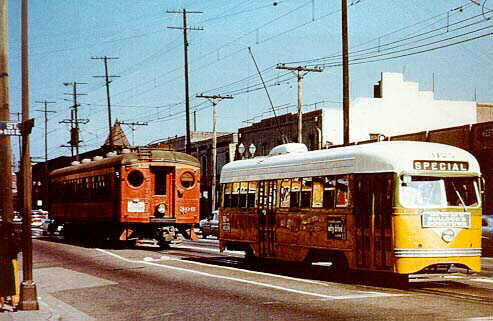 Los Angeles Railway's yellow streetcars once provided a rail network for the central city, while Pacific Electric higher-speed Red Car trolleys (here sharing a stretch of track with streetcars) provided fast regional service.
Los Angeles Railway's yellow streetcars once provided a rail network for the central city, while Pacific Electric higher-speed Red Car trolleys (here sharing a stretch of track with streetcars) provided fast regional service.
[Photo: Trolleys-California]
LA's expanding rail transit system
Perhaps not widely known is the fact that, since the 1990s, LA has undertaken a vigorous rail transit installation program that amounts to a revival of several of these original rail lines.
The modern system is competently and succinctly described in a Wikipedia article which summarizes the lines that have been constructed and in operation so far:
>>
Metro Rail consists of five separate named lines identified by a color, as are the distinct Metro Liner services, which are actually bus services operating along guided busways.
The Metro rail line[s] are as follows: ...
• The Metro Red Line is a heavy rail subway line that connects Downtown Los Angeles to North Hollywood, passing through several neighborhoods in Hollywood and Mid-Wilshire.
• The Metro Purple Line is a heavy rail subway line running between Downtown Los Angeles and Koreatown/Mid-Wilshire.
• The Metro Blue Line is a light rail line running between Downtown Los Angeles' Financial District and Downtown Long Beach. In between, the line serves several neighborhoods and cities in the county's south-central region, including Huntington Park, South Gate, Willowbrook and Compton.
• The Metro Green Line is a fully elevated light rail line running between Redondo Beach and Norwalk. In between, the line serves several neighborhoods and cities, including El Segundo, Hawthorne, and Lakewood. It offers indirect access to Los Angeles International Airport via a shuttle bus from the Aviation/LAX station.
• The Metro Gold Line is a light rail line that runs between East Los Angeles and Pasadena, passing through Boyle Heights, Little Tokyo, Downtown Los Angeles, Highland Park and South Pasadena.
The Red and Purple Lines follow a fully underground route (subway), and the Green Line follows a fully elevated route. The Blue and Gold Line routes run in a mix of environments, including at-grade street running, at-grade ROW, elevated, and underground. ...
The two heavy-rail lines (Red and Purple) share right-of-way between Union Station and Wilshire/Vermont. Currently, none of the three light-rail lines share right-of-way, although they use compatible technologies. Future system expansions are expected to utilize shared light-rail rights-of-way.
<<
The map below illustrates the rail lines currently in operation, plus the Orange Line busway ("bus rapid transit") line running east west in the northwest section of the urban area, and the Silver Line bus "transitway" (also "BRT"), running west from El Monte to downtown and then south to Harbor Gateway.
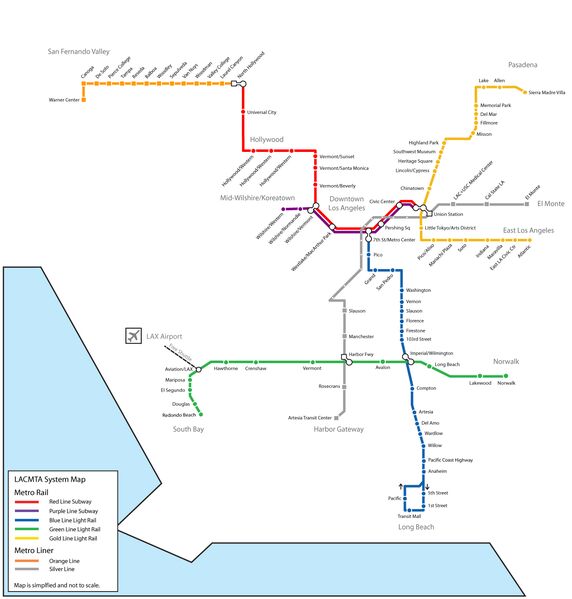
[Map: Wikipedia]
Major new transit projects under way
Currently under construction is the Expo light rail transit (LRT) line, routed via the Exposition Blvd. corridor ultimately to Santa Monica.
New projects are reported by the Times article, starting with the long-awaited extension of the city's hard-working rail rapid transit (subway) system by the Metropolitan Transportation Authority (MTA):
>>
Los Angeles transit officials, after years of debate, have approved an 8.6-mile extension of the Purple Line subway, from Koreatown through a crowded corridor of offices, homes, museums, schools and shopping centers in Beverly Hills, Century City and Westwood.
What once seemed a quixotic vision – the "Subway to the Sea," connecting Union Station in downtown to the Pacific Ocean in Santa Monica – no longer seems quite so quixotic.
<<
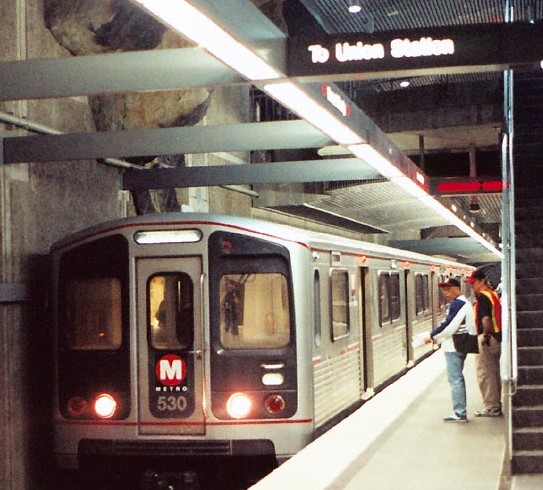 Major expansions to LA's rail rapid transit (subway) system are under way.
Major expansions to LA's rail rapid transit (subway) system are under way.
[Photo: Eric Haas]
Major extensions of LA's light rail transit (LRT) lines are also highlighted by the Times report:
>>
At the same time, Los Angeles received $546 million from the federal government to build, over the next 10 years, an 8.5-mile above-ground light-rail line from the Crenshaw district to Los Angeles International Airport.
An 11-mile extension of the Metro Gold Line, which starts in East Los Angeles and will eventually go out to Montclair, began in June, and construction is set to begin this year extending the Exposition Light Rail Line from Culver City to Santa Monica.
<<
As the Times goes on to note, "with a vote by the Los Angeles County Metropolitan Transit Authority's board last month to approve the Purple Line expansion, there is a consensus that these projects are going to be built, even among those who describe them as a waste of money in a region that will never embrace mass transit."
>>
The projects are being financed by a half-cent sales tax surcharge approved by Los Angeles voters two years ago and expected to raise $40 billion over the next 30 years.
<<
Coming in the context of seemingly lunatic-like repudiation of "public spending" on major public infrastructure projects by a federal political structure dominated by rightwing extremists, LA's ambitious public transportatuon expansion program is even more amazing.
As the Times article points out,
>>
Taken together, these developments have emboldened mass transit enthusiasts here and lent credibility to what has become something of a legacy project for Mayor Antonio R. Villaraigosa, who ran for office pledging to build a transit system that would upend long-established commuting habits and ease what has long been a bane of life in Los Angeles.
<<
But the full list of rail project expansions goes significantly beyond the handful of projects featured in the Times article.
These include totally new lines, extensions of existing lines, and facilities and rolling stock upgrades to both rapid rail and LRT systems and to the Metrolink regional passenger rail ("commuter") system.
The scope of these major rail projects is indicated by the red lines on the Projects map provided by MTA:
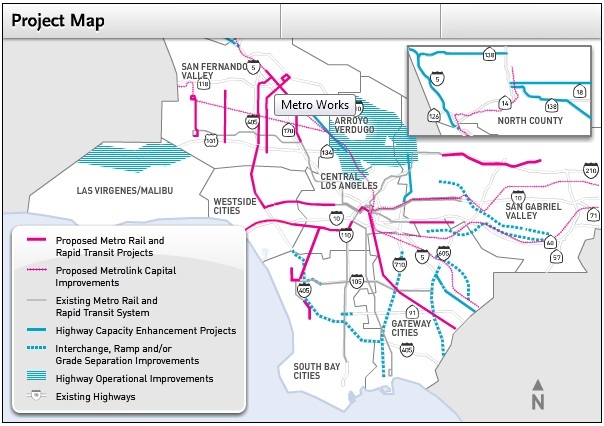
[Map: MTA]
The following descriptive summary of current projects is adapted from material on the MTA's website:
 Crenshaw/LAX Transit Corridor (project acceleration)
Crenshaw/LAX Transit Corridor (project acceleration)
• Accelerates construction of a line along the Crenshaw Bl Corridor and connects Los Angeles, Inglewood, Hawthorne and El Segundo, plus unincorporated LA County.
Region(s): City of Los Angeles, South Bay cities
Projected investment: $1.21B
Status: MIS/EIR/EIS/EA Final Phase
 East Light Rail Access (Gold Line)
East Light Rail Access (Gold Line)
• Increases access, including pedestrian and bicycle, to the Gold Line Eastside Light Rail project.
• Region(s): City of Los Angeles
• Projected investment: $30.0 million
• Status: Ongoing
 Eastside Transit Corridor Phase 2
Eastside Transit Corridor Phase 2
• Extends Metro Gold Line farther east from the Pomona/Atlantic Station.
• Region(s): Gateway Cities, San Gabriel Valley
• Projected investment: $1.27 billion
• Status: MIS/EIR/EIS/EA Draft Phase
 Exposition Transit Corridor, Phase II
Exposition Transit Corridor, Phase II
• Extends the Exposition Rail Line, currently under construction to Culver City, to Santa Monica.
• Region(s): City of Los Angeles, Westside cities
• City: Los Angeles
• Projected investment: $925 million
• Status: MIS/EIR/EIS/EA Final Phase
 Gold Line Foothill Extension
Gold Line Foothill Extension
• Extends the Metro Gold Line from its current terminus in Pasadena toward Claremont.
• Region(s): San Gabriel Valley
• Projected investment: $735 million
• Status: Preliminary Engineering
 Green Line Extension to Los Angeles International Airport
Green Line Extension to Los Angeles International Airport
• Links the Metro Green Line to LAX at the Aviation Station.
• Region(s): City of Los Angeles, South Bay cities
• Projected investment: $200 million
• Status: Alternative Analysis Study
 South Bay Green Line Extension
South Bay Green Line Extension
• Extends the Metro Green Line from its current terminus in Redondo Beach to the South Bay Galleria.
• Region(s): South Bay cities
• Projected investment: $272 million
• Status: MIS/EIR/EIS/EA Draft Phase
 Westside Subway Extension (to be opened in segments)
Westside Subway Extension (to be opened in segments)
• Extends Metro Rail to the Westside. The project is expected to serve Century City and Westwood/UCLA.
• Region(s): City of Los Angeles, Westside cities
• Projected investment: $4.07 billion
• Status: MIS/EIR/EIS/EA Final Phase & Preliminary Engineering
 Metro Rail Capital Projects
Metro Rail Capital Projects
• Maintains rail facilities by improving operational systems, upgrading rail yards and purchasing new rail cars.
• Region(s): Regionwide Programs
• Projected investment: $788 million
• Status: Ongoing
 Metrolink Capital Improvement Projects (Los Angeles County)
Metrolink Capital Improvement Projects (Los Angeles County)
• Purchases trains, expands the Eastern Maintenance Facility and upgrades sidings and crossovers to increase speed and safety. Local jurisdictions could use funds to improve parking and station facilities within their cities and offer connecting shuttle services.
• Region(s): Regionwide Programs, San Fernando Valley
• Projected investment: $1.18 billion
• Status: Ongoing
 Regional Connector: Transit Corridor
Regional Connector: Transit Corridor
• Links four light rail lines that terminate at the edges of Central LA. Expected to provide seamless connections between Long Beach/Claremont, and Culver City/East LA, minimizing the need for rail transfers.
• Region(s): City of Los Angeles, Gateway Cities, San Gabriel Valley, South Bay cities, Westside cities
• Projected investment: $160 million
• Status: Preliminary Engineering Advanced Conceptual Engineering/Preliminary Engineering
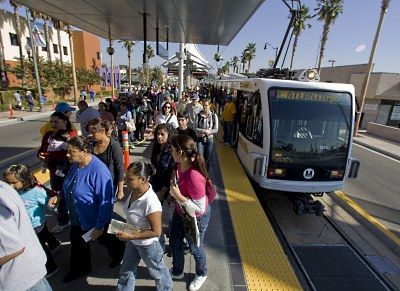 LRT projects are are also included in LA's massive public transportation expansion and upgrade program.
LRT projects are are also included in LA's massive public transportation expansion and upgrade program.
[Photo: Eric Reed]
In addition to these explicitly rail projects is another array of multi-modal, bus, and other types of transit projects also in various phases of development:
 East San Fernando Valley North-South Transit Corridors
East San Fernando Valley North-South Transit Corridors
• Accelerates bus service improvements, including possible dedicated bus lanes, on four potential East San Fernando Valley corridors, including Van Nuys, Sepulveda, Reseda and Lankershim.
• Region(s): City of Los Angeles, San Fernando Valley
• Projected investment: $68.5 million
• Status: Alternative Analysis Study Early Planning
 Metro Orange Line Extension
Metro Orange Line Extension
• Extends the Metro Orange Line north from Canoga Park Station to Chatsworth with a projected completion three years early.
• Region(s): City of Los Angeles, San Fernando Valley
• Projected investment: $182 million
• Status: Construction
 Sepulveda Pass Transit Corridor
Sepulveda Pass Transit Corridor
• Provides a rapid transit option to improve traffic flow between the Westside and the San Fernando Valley through the Sepulveda Pass along the I-405 freeway corridor. It will provide a viable alternative to driving on a heavily congested freeway. Specific transit technology and routing will be subject to approved plans developed in cooperation with local jurisdictions and affected communities.
• Region(s): City of Los Angeles, San Fernando Valley
• Projected investment: $1.0 billion
• Status: Initial Planning
 West Santa Ana Transit Corridor
West Santa Ana Transit Corridor
• Provides for the development of a grade-separated transit corridor. Phase I is designed to go from the LA County line toward downtown LA.
• Region(s): City of Los Angeles, Gateway Cities
• Projected investment: $240 million
• Status: Alternative Analysis Study
Ridership growth refutes critics
Yet, even while this armada of public transportation projects proceeds, says the Times, "battles" are still being waged, particularly over the effort to re-install a relatively small portion of the originally widespread Yellow Car and Red Car system that once inter-connected with LA region.
Tom Rubin, described by the article as "a mass transit consultant in Oakland", blasted away at the subway expansion project as "fiscal folly that would serve only to take resources away from the widely used, if less efficient, network of buses", according to the Times.
"They have been pushing rail expansion for decades now" Rubin told the paper, asserting that "it has not had much of an impact in terms of increasing transit ridership."
>>
The big problem is that these are very, very expensive, and we wind up spending so much money on building these rail lines that there is not enough to operate bus service.
So we wind up cutting back on bus operations and then raising fares, which drives the riders away.
<<
These claims are utter nonsense, made even more outrageous by Rubin's portrayal as a "mass transit consultant".
According to documentary statistical reports from the American Public Transportation Association and the Federal Transit Administration, LA's core bus-only transit system in 1990, before the impact of the first rail transit line, carried 419.2 million rider-trips and 1,711.9 passenger-miles.
In 2007, just as the economic crash began to hit, the combined MTA bus and rail system carried 495.3 million trips and 2,035.3 passenger-miles.
That's an 18% increase in ridership and a 19% increase in passenger-miles.
The Times suggested that the improvements now being implemented had the potential of delivering even more impressive increases in public transit use in this iconically auto-centric metro area.
>>
Robert B. Cervero, the director of the University of California Transportation Center in Berkley, said that if the subway expansion cut commuting time as promised, it would indeed change ridership habits.
Transit officials said the ride from Koreatown to Westwood by subway would take 24 minutes, compared with 50 minutes during the rush in a car or on a bus.
<<
"The science of public transit is not too complicated" Dr. Cervero told the Times.
>>
It comes down to how time-competitive transit is with the private car.
If it takes two to three times longer to get from Point A to Point B by transit, the vast majority of folks will drive.
If it's faster going by bus or train, then most will forsake their car and ride transit.
<<
Joel Epstein, cited by the Times as a "mass transit advocate", told the paper that evolving demographic and population patterns – plus continuously escalating frustration over traffic – "would inevitably drive people from cars underground."
"There's a whole new type of Angeleno who has no cultural opposition to riding," Epstein emphasized.
"The whole old-school L.A. thinking that people don't ride subways, that's a thing of the past."
Light Rail Now! website
URL: http://www.lightrailnow.org/news/n_la_2011-02a.htm
Updated 2011/02/02
More on Public Transport in Los Angeles
More on Rail Transit Development...
|